By June Allen December 07, 2003
One of those was Navy Ensign Irvin Thompson, 24, of Ketchikan. He was lost in the sinking of the battleship Oklahoma, Alaska's first serviceman casualty of World War II. In his honor, flags would fly at half-mast throughout Alaska Dec. 21, by proclamation of Territorial Governor Ernest Gruening. 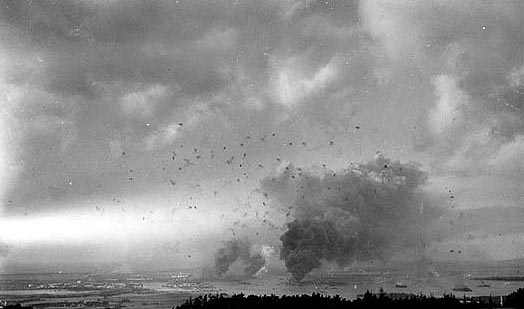 Pearl Harbor Attack, 7 December 1941 Official U.S. Navy Photograph, now in the collections of the National Archives. In spite of the fact that the United States had declared neutrality in Hitler's "European war" on Sept. 5, 1939, most citizens expected that eventually the country would be drawn into the conflict. What few expected was that any nation would dare to attack the United States! The attack on Pearl Harbor came as an outrage and war was immediately declared. In Ketchikan, in shock like the rest of the nation, there were whispered rumors of Japanese cannery workers and bookkeepers having hidden short wave radios. In fact, a more specific rumor said that a spy at Waterfall Cannery had been evacuated by an enemy submarine under cover of night. There was a rumor of enemy submarines off Prince of Wales Island - a rumor that soon after earned some credibility when remote areas in British Columbia and the Oregon coast were lobbed with incendiary bombs launched from enemy subs. The distant Hawaiian Islands and the rest of the world, accessible to Ketchikan only by steamship or Clipper flights, had seemed remote to the little town - until that day. Until Dec. 7, 1941, one of the looming local problems was finding a way to move the garbage dump from the unsightly, overflowing shoreline just south of the Coast Guard base to a new location at what is now called Wolfe Point. Suddenly Ketchikan found itself a not-so-distant part of the world in which garbage dumps were the least of the problems. 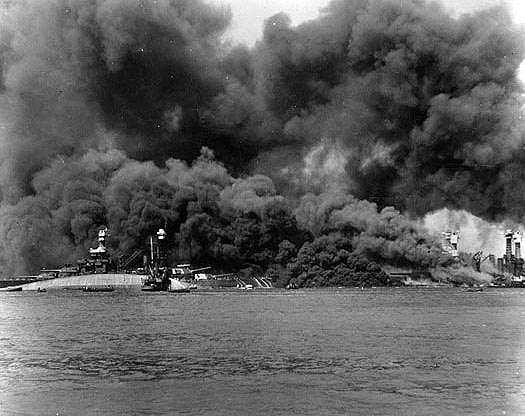 Pearl Harbor Attack, 7 December 1941 Official U.S. Navy Photograph, now in the collections of the National Archives The other local bone of contention at the time was electric power - or the lack of it. A dry summer that year meant low lake levels, so New England Fish Co. and Ketchikan Spruce Mill shared their power with the city. Then a storm flooded and knocked out the spruce mill supply. So the city fathers jacked up the Ketchikan Public Utilities rates to discourage electric heating and met in shiveringly cold council chambers themselves. At the sudden outbreak of war, those KPU concerns faded as did Ketchikan's electric lights. Along with all American Pacific Coast cities, Ketchikan went into immediate preparedness and blackout because city lights backlighted ships far out to sea, putting them in danger of enemy submarine attack. Ketchikan had the Coast Guard Base to protect from the threat. Stores and homes put up required blackout shades and curtains and some built double-entry blackout doorways for use at night. Quickly recruited watchmen patrolled the city at night, making sure no light was showing. At the urging of the Ketchikan Volunteer Fire Department, owners of flat-roofed businesses hauled barrels of sand to rooftops to be used in the events of incendiary bombs. Chuck Cloudy was a 17-year-old high school senior that December. He and his date came out of a Sunday matinee at the Revilla Theater that Dec. 7 and saw men lined up in front of the Miners & Merchants Bank (the NBA/Wells Fargo building), waiting to enlist. Soon after young Cloudy became an air raid warden in his Harding Street neighborhood. He recalled that young men not yet of military age were recruited along with others for firearms practice at the town's rifle range, in the same place as today, with weapons that had not been out of their cosmoline packing since the end of World War I. 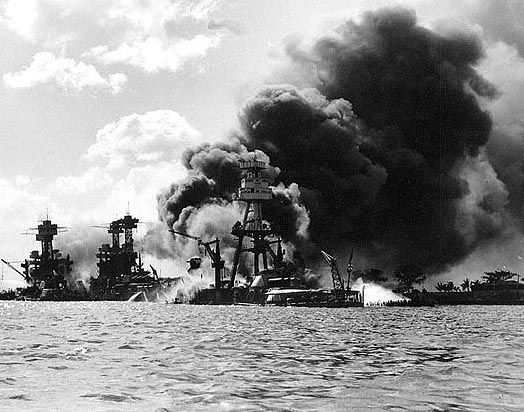 Pearl Harbor Attack, 7 December 1941 Official U.S. Navy Photograph, from the collections of the Naval Historical Center. In those first few days after the Pearl Harbor attack, Ketchikan's newspaper stories indicate a fever of patriotism and caution sweeping the town. The city's few neon signs had to be turned off. Radio silence - and everyone listened to the radio - was a signal for total blackout . City league basketball was called off. The Ketchikan chapter of the Red Cross set a quota of $4,000 and raised much more. Steamship companies would no longer give out passenger lists. Parking on the right-hand side of the streets was prohibited and parking on some of the narrower streets was banned altogether. Victory bond sales soared to $12,000 in one week and school kids were selling defense stamps. There was a fear that because of uncertain shipping schedules that turkeys would not arrive in time for Christmas! Air raid drills became common that late winter and spring of 1942. Everybody took first aid lessons. The elementary and high school students at Main School, then the only school other than White Cliff, were led to the safety of the shaft of the Schoenbar mine in Bear Valley during evacuation exercises. Trails were hacked into the woods to be used in the event of larger evacuation needs and residents were urged to store caches of non-perishables there. Just six months later, during the first week of June, Japanese forces attacked Alaska's Dutch Harbor - Alaska's back door - and preparedness was at fever pitch. Alaska realized that the war was "the real thing." For the first and only time in history - until the 9-11 terrorist attacks - America was attacked on American soil! The Aleutian Islands of Attu and Kiska were invaded and occupied. 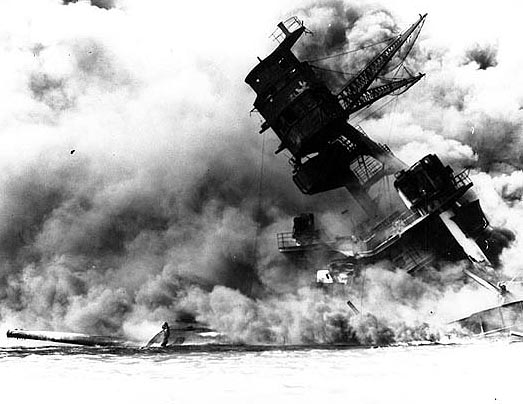 USS Arizona Pearl Harbor Attack, 7 December 1941 Official U.S. Navy Photograph, from the collections of the Naval Historical Center. The little town of 5,000 on Tongass Narrows found itself host to hundreds of soldiers, weekend pass visitors from the 10,000 Army engineers building Annette airfield. The men slept on the docks, and didn't care! The USO in the old city warehouse building on Water Street did a land office business. Ketchikan's high school girls flirted and dated some of the young men and learned semaphore code signals to greet their dates as the boats from Annette neared the docks. City Park became a campground for visiting troops. The Ketchikan Selective Service Board held regular meetings. From the Chilkoot Barracks at Haines - Alaska's only Army facility at the outbreak of war - a columnist calling himself "The Jawboned Corporal" wrote about Ketchikan's Cliff Phillips as captain of the basketball team and Ragnar Myking as guard. Myking, later killed in the war, would be honored by having Ketchikan's new post-war Veterans of Foreign Wars post named in his honor. Many of Ketchikan's young men would serve in the Aleutian campaign, a theater of war that was blocked from press coverage immediately after the Japanese attacks on Dutch Harbor and the invasion and occupation of two of the Aleutian Islands, Kiska and Attu. President Franklin D. Roosevelt ordered the news blackout in the fear that the realization of the enemy's presence on Alaska soil would panic the entire nation. There were other emergency orders shortly after the shock and tragedy of Pearl Harbor. One was that Alaska Natives, Aleuts from the remote and treeless islands of the Aleutians, were evacuated to temporary "camps" at locations along the Southeastern Panhandle before they could be returned to their villages. Some were housed in a the old CCC barracks at Ward Lake for a year. They did not fare well in the rain forest climate and conditions. Today that removal and confinement seems barbaric; it did not seem so at the time. 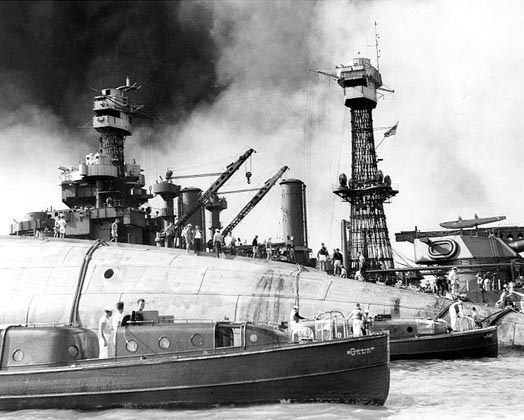 Pearl Harbor Attack, 7 December 1941 Rescue teams at work on the capsized hull of USS Oklahoma (BB-37), seeking crew members trapped inside, 7 December 1941. The starboard bilge keel is visible at the top of the upturned hull. Officers' Motor Boats from Oklahoma and USS Argonne (AG-31) are in the foreground. USS Maryland (BB-46) is in the background. Official U.S. Navy Photograph, now in the collections of the National Archives. The other emergency order was to remove all of America's Japanese residents, including Japanese-Americans, inland to internment camps in the States. Ketchikan's Japanese-American families, some of those families having come to Ketchikan shortly after the turn of the century, were evacuated. In Ketchikan, neighbors willingly took care of vacant properties for their friends and some of the evacuees returned to Ketchikan after the war and resumed their lives. Today those events seem far in the past, part of the remote past. A baby born that year of the sneak attack on Pearl Harbor would be 62 years old today. But any of us who remember that Day of Infamy remember it with crystal clarity! As international affairs evolve today, we can only say, always "Remember Pearl Harbor!
Related Story:
All rights reserved. Not to be reprinted in any form without the written permission of June Allen.
E-mail June: june@sitnews.org
|
||||


